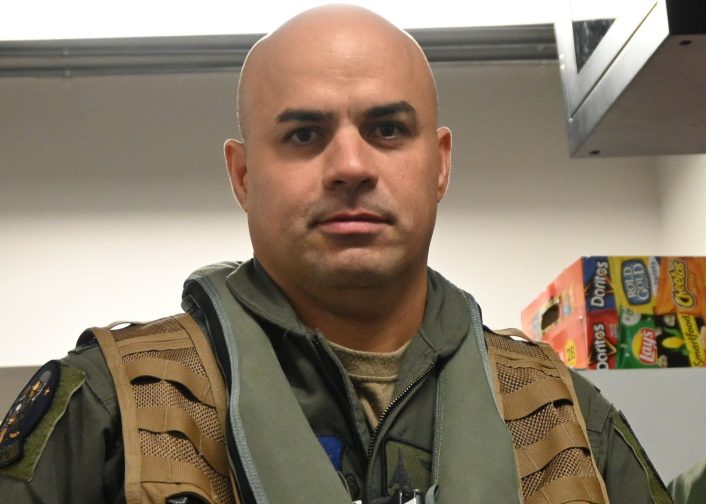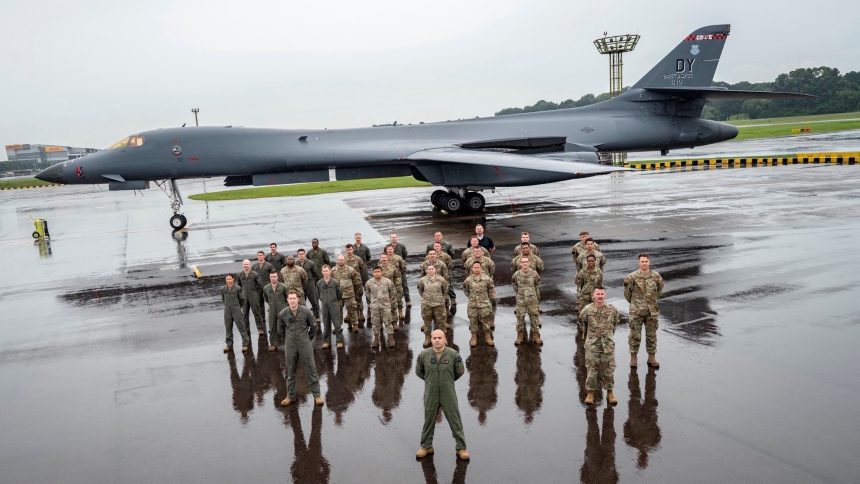Lt. Col. Alvarez, a B-1B weapons systems officer and commander of the 345th Bomb Squadron, joins a short list of aircrew who have amassed 5,000-plus flying hours in the B-1B.
Lt. Col. Eric Alvarez, a weapons systems officer (WSO) and commander of the 345th Bomb Squadron which flies the B-1B Lancer bomber from Texas’ Dyess AFB, crossed the 5,000 flight hours threshold on the aircraft, making it to a list of “only a handful of people to ever reach the mark,” said a U.S. Air Force release. Alvarez later specified that his flight time on the bomber was precisely 5,001.8 hours.
Flying was a childhood dream that led to Alvarez seeing 14 years of active-duty service and 10 years in the Air Force Reserve, inspired by his duties in the service, rather than “meeting a certain number of hours,” which he “never cared much about.” In the release, Alvarez reflected upon his experience, beginning with his passion for flying and military aviation, his training, how he learned from colleagues, family and how they collectively contributed to him achieving this rare feat.
The USAF has also celebrated other pilots of its bomber fleet attaining flight hour thresholds, as reported by The Aviationist. B-2 Spirit pilot and 110th BS commander Lt. Col. Justin Meyer became the first Air Force pilot to log 2,000 flight hours on the stealth jet after taking off from Whiteman AFB, Missouri, on Jun. 6, 2024. Sep. 24, 2024 also saw Gary Hogg, a seasoned test pilot of the C-130 Hercules clocking 10,000 flight hours on the aircraft during a routine C-130H avionics modernization test.

Lt. Col. Alvarez’s journey
In pursuit of his childhood dream to fly, Lt. Col. Alvarez took “additional prep courses” to crack the tests, and eventually ended up in the officer training school. “I did not get my initial pick, which was fighter jets, but they gave me bombers, the B-1B, and looking back on that, I have zero regrets,” he said.
His “zero regrets” attitude landed him on the short list of aircrew who have amassed 5,000-plus flying hours in the B-1B. The 5,001.8 hour mark, according to Alvarez, took over 20 years, starting with his first flight in Oct. 2004, before a routine Unit Training Assembly (UTA) on a weekend in May 2025 saw him reaching the milestone.
Alvarez never really aimed for the distinction, and was “caught off guard” after being met by family and colleagues following the historical flight. “It didn’t hit me until I was greeted by my family and friends after I landed because we kept going along like any other sortie with what we trained to do – go up and fly, be ready with our tactics and procedures. Train, fly and land, and oh, by the way, you’ve reached 5000 hours!” he said.
A B-1B Lancer assigned to the 34th Expeditionary Bomb Squadron takes off in support of Bomber Task Force 25-1 at Andersen AFB, Guam Feb. 24, 2025. (Robert M. Trujillo) pic.twitter.com/rnc9zitKc7
— J.J. (@kadonkey) March 2, 2025
“It wasn’t really about the hours, it was about my family, the team, the generation after generation,” he said. “The opportunities to go from active-duty to the Reserve and continue to train, fight, and serve the Air Force in this nation were what I was most thankful for in that moment.”
His next step is to keep “serving his country for as long as he can,” but only until his body tells him to and “focus shifts towards things like spending more time with family.”
For now, he wants to focus on mentoring the younger generations of Airmen with his knowledge, experience, and advises them to “stay focused on the task and embrace lessons from those around them.” Saying it is the “squadrons, leadership, the families, the inner circle” that keep the USAF going, he added that he “hopes to instill and foster community within the 345th BS to accomplish the Air Force Reserve Command and 307th Bomb Wing missions.”
We love “the Bone.” 😎🦴
B-1 Bombers from the 37th Expeditionary Bomb Squadron are currently deployed to Andersen Air Force Base, Guam for a Bomber Task Force deployment, assuring partners and allies and promoting a #FreeandOpenIndoPacific. pic.twitter.com/pJBDB2PNIs
— PACAF (@PACAF) July 24, 2020
History of the 345th Bomb Squadron
The 345th Bomb Squadron, assigned to the 489th Bomb Group (489th BG), a geographically separated unit of the 307th Bomb Wing (307th BW), was originally established as a B-24 Liberator unit on Jan. 28, 1942. It saw extensive service in World War II, especially over southern and north Africa (Egypt, Libya, Tunisia) supporting the British Eighth Army striking Nazi and Italian targets in Italy and the Balkans, occupied France and Germany.
On May 23, 1945 it was redesignated into a B-29 Superfortress (Very Heavy) bomb squadron to see service in the Pacific theater with Japan, before being redesignated as a Strategic Air Command B-29 Superfortress (Medium) bomb squadron on 28 May 1948, seeing action in the Korean War. The unit was then reassigned to Nebraska’s Lincoln AFB and converted to the B-47E Stratojet.

The 345th BS was reactivated in October 2015 as an Air Force Reserve Command (AFRC) B-1B Lancer bomb squadron operating in a classic association with the 9th Bomb Squadron, supporting the Air Force Global Strike Command’s (AFGSC) B-1 deployable combat operations.
For instance, on Oct. 10, 2024 a B-1B from the 9th BS returned to Dyess AFB from a U.S. Indo-Pacific Command (INDOPACOM) mission in support of the Korean Armed Forces Day on Oct. 1 that year, and upon landing was greeted by 345th BS personnel. A caption also called the short deployment a CONUS (Continental United States) to CONUS mission.









